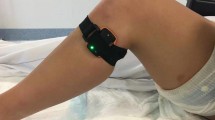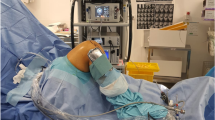Abstract
Purpose
Dynamic laxity is clinically demonstrated with the pivot-shift (PS) test. Recently, a new system that measures the acceleration of the tibia during the PS test was validated. The goal of the present study was to use the accelerometer “KiRA” to evaluate the efficacy of measuring PS.
Methods
Between 2010 and 2011, a total of 100 patients with anterior cruciate ligament (ACL) lesions were enrolled. They underwent surgical reconstruction of the ACL. Among them, 30 patients were re-evaluated at least 6 months after surgery. Each patient underwent a clinical examination (Lachman test, anterior drawer test, and PS test) and then was subjected to an instrumental examination: KT1000 evaluation to quantify the Lachman test and KiRA to quantify the PS test.
Results
The accelerometer found a positive acceleration difference in favour of the pathologic knee. In the 100 patients evaluated preoperatively, the analysed acceleration parameters on the pathologic knee were found to be significantly different with respect to the contralateral joint. Correlating the clinical subjective data with numerical data, we identified mean reference values for every grade of the PS test (negative, glide, and clunk).
Conclusion
Our experience showed us that the use of KiRA accelerometer for quantitative measurement of the PS is both promising and reliable. The efficacy of this instrument is strictly related to an inevitable learning curve and to proper execution of the test. It has the value of being easy to set up and easy to use in both the clinic and the operating room.




Similar content being viewed by others
References
Almquist PO, Arnbjornsson A, Zatterstrom R et al (2002) Evaluation of an external device measuring knee joint rotation: an in vivo study with simultaneous Roentgen stereometric analysis. J Orthop Res 20:427–432
Araujo PH, Rabuck SJ, Fu FH (2012) Comparison of three non-invasive quantitative measurement systems for the pivot shift test. Knee Surg Sports Traumatol Arthrosc 20:692–697
Bedi A, Mushal V, Lane C (2010) Lateral compartment translation predicts the grade of pivot-shift: a cadaveric and clinical analysis. Knee Surg Sports Traumatol Arthrosc 18(9):1269–1276
Bignozzi S, Zaffagnini S, Lopomo N (2009) Does lateral plasty control coupled translation during antero-posterior stress in single-bundle ACL reconstruction? An in vivo study. Knee Surg Sports Traumatol Arthrosc 37(5):890–897
Bleday RM, Fanelli GC, Giannotti BF, Edson CJ, Barrett TA (1998) Instrumented measurement of the posterolateral corner. Arthroscopy 14:489–494
Daniel D, Malcom L, Losse G, Stone M, Sachs R, Burks R (1985) Instrumented measurement of anterior laxity of the knee. J Bone Joint Surg Am 67:720–726
Ranawat A, Pombo M, Harner C (2008) Single-bound ACL reconstruction technique: medial portal. In: Fu F (ed) Current concepts in ACL reconstruction. Slack Incorporated, pp 215–232. http://www.healio.com/books/orthopedics/%7Baf40084d-97c3-4b38-a0c5-62830c9bf61c%7D/current-concepts-in-acl-reconstruction
Galway HR, MacIntosh DL (1980) The lateral pivot shift. A symptom and sign of ACL insufficiency. Clin Orthop Relat Res 147:45–50
Graham GP, Johnson S, Dent JM (1991) Comparison of clinical tests and the KT1000 in the diagnosis of anterior cruciate ligament rupture. Br J Sports Med 25(2):96–97
Hoshino Y, Kuroda R, Nagamune K (2007) In vivo measurement of the Pivot-Shift test in the anterior cruciate ligament deficient knee using an electromagnetic device. Am J Sports Med 35(7):1098–1104
Kopf S, Kauert R, Halfpaap J (2012) A new quantitative method for pivot shift grading. Knee Surg Sports Traumatol Arthrosc 20:718–723
Lopomo N, Bignozzi S, Zaffagnini S (2008) Quantitative correlation between IKDC score, static laxity, and Pivot-Shift test: a kinematic analysis of knee stability in anatomic double-bundle anterior cruciate ligament reconstruction. Oper Tech Orthop 18(3):185–189
Lopomo N, Signorelli C, Zaffagnini S et al (2012) Quantitative assessment of Pivot-Shift using inertial sensors. Knee Surg Sports Traumatol Arthrosc 20(4):713–717
Lopomo N, Zaffagnini S, Signorelli C (2011) An original clinical methodology for non-invasive assessment of Pivot-Shift test. Comput Methods Biomech Biomed Engin 15(12):1323–1328
Malcom LL, Daniel DM, Stone ML (1985) The measurement of anterior knee laxity after ACL reconstructive surgery. Clin Orthop Relat Res 196:35–41
Maeyama A, Hoshino Y, Debandi A (2011) Evaluation of rotational instability in the anterior cruciate ligament deficient knee using triaxial accelerometer: a biomechanical model in porcine knees. Knee Surg Sports Traumatol Arthrosc 19:1233–1238
Mesàt P, Trc T, Dylevský I et al (2005) ACL reconstruction, long term results evaluated clinically and by means of a rolimeter. Acta Chir Orthp Traumatol Cech 72(1):32–37
Muellner T, Bugge W, Johansen S (2001) Inter- and intratester comparison of Rolimeter knee tester: effect of tester’s experience and examination technique. Knee Surg Sports Traumatol Arthrosc 9:302–306
Musahl V, Ayeni O, Citak M (2010) The influence of bony morphology on the magnitude of the pivot shift. Knee Surg Sports Traumatol Arthrosc 18(9):1232–1238
Norwood LA, Cross MJ (1979) ACL: functional anatomy of its bundles in rotatory instabilities. Am J Sports Med 7:23–26
Uh BS, Beynnon BD, Churchill DL, Haugh LD, Risberg MA, Fleming BC (2001) A new device to measure knee laxity during weightbearing and non-weightbearing conditions. J Orthop Res 19:1185–1191
Wright RW (2009) Knee injury outcomes measures. J Am Acad Orthop Surg 17(1):31–39
Zaffagnini S, Marcheggiani Muccioli GM (2012) Can the Pivot-Shift be eliminated by anatomic double-bundle anterior cruciate ligament reconstruction? Knee Surg Sports Traumatol Arthrosc 20:743–751
Author information
Authors and Affiliations
Corresponding author
Rights and permissions
About this article
Cite this article
Berruto, M., Uboldi, F., Gala, L. et al. Is triaxial accelerometer reliable in the evaluation and grading of knee pivot-shift phenomenon?. Knee Surg Sports Traumatol Arthrosc 21, 981–985 (2013). https://doi.org/10.1007/s00167-013-2436-9
Received:
Accepted:
Published:
Issue Date:
DOI: https://doi.org/10.1007/s00167-013-2436-9




